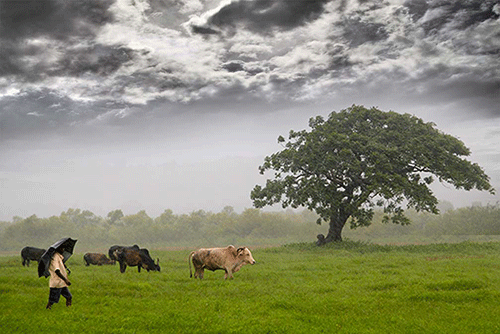Erastus Ngaruka
As Namibian farmers eagerly anticipate a favourable rainy season as forecast, the signs of climate change still linger.
Every rainy season has become spatially and temporally unique in terms of its initiation, intensity, distribution and duration.
This means farmers need to continuously prepare for every rainy season, as each season may present different challenges and consequences.
These include floods, lightning, heavy winds, cold, drought, disease and pest outbreaks, amongst others.
The previous rainy season provided much-needed relief for many livestock farmers in the country as the grazing capacity improved, although not optimally in terms of value.
All the while, the density of unwanted plant species has increased as well. Much of the forage yield from the previous season was underutilised due to poor grazing value, and a significant number of grazing animals, especially cattle, were drastically reduced during the drought years.
This has left a huge amount of grass as fuel load, which has intensified the impact of veld fires, which can destroy large tracts of grazeable land.
Veld fires have already been recorded in many areas around the country, with the most recent one experienced in the Rehoboth area in the Hardap region.
As much as farmers always wish for a good rainy season to improve their grazing conditions, they must also be cautious of and prepare for the veld fire events at the end of the season.
To this end, it is very important that the rangelands are prepared to benefit from rainfall while ensuring sufficient forage materials are preserved, protected and available until the next season.
At this point, farmers need to adopt sustainable and restorative rangeland utilisation practices, such as re-seeding with valuable perennial grasses, bush-thinning, soil condition improvement and protection, prevention of soil erosion and sustainable grazing practices that could also minimise the impact of fire while reserving grazing.
With heavy showers predicted, farmers need to prepare and protect farm infrastructure and livestock from possible floods, especially in risky areas, such as the northern parts of the country.
Moreover, farmers need to adopt techniques of harvesting rainwater and storage for later use in gardens and other household needs.
On the other hand, moist environmental conditions also predispose the prevalence of insects such as mosquitoes, ticks, and biting flies.
These insects can transmit common diseases like lumpy skin disease, tick-borne diseases, such as sweating sickness and anaplasmosis (gall sickness), amongst others.
To this end, farmers need to vaccinate their animals, especially against lumpy skin disease by November, as it can also disturb cattle marketing when there is an outbreak.
Like the previous rainy season, there will be a high prevalence of internal parasites, more especially the liver fluke, amongst others.
The liver fluke’s intermediate host is a snail – and as it moves around, it leaves it on the grass or water.
It is advisable to understand the seasonal prevalence of parasites and related symptoms, such as itching, anaemia, bottle jaw, diarrhoea and running nose, and to select the correct anthelmintics or antiparasitic remedies. As much as rainfall provides relief for livestock farmers, it can also be a disturbance to the well being of livestock.
Apart from diseases and parasite prevalence, rainfall also comes with cold and windy conditions, lightning strikes and damp environments that can be unhygienic and uncomfortable for the livestock – for example, muddy kraals. Livestock kraals should always be cleaned and sheltered to protect animals from rain, cold, wind and lightning.
These stressful conditions can result in incidences of lung infection (pneumonia or pasteurellosis), especially in goats and sheep. However, pasteurellosis can be prevented through vaccination.
Furthermore, rainfall also affects livestock foraging activities, limiting their foraging time and daily intake as they run for cover to avoid getting wet.
To that end, extra feed should be provided to compensate for the possible loss of dry matter intake and enhance the animals’ metabolism for them to keep warm from metabolic heat.
Lastly, livestock farmers need to maintain hygienic and safe environments for their animals to ensure their welfare and performance are not compromised.
They need to keep abreast with information related to climatic activities and prepare for every challenge that can possibly come with every rainy season.
Erastus Ngaruka is AgriBank’s technical advisor for livestock and rangeland management


